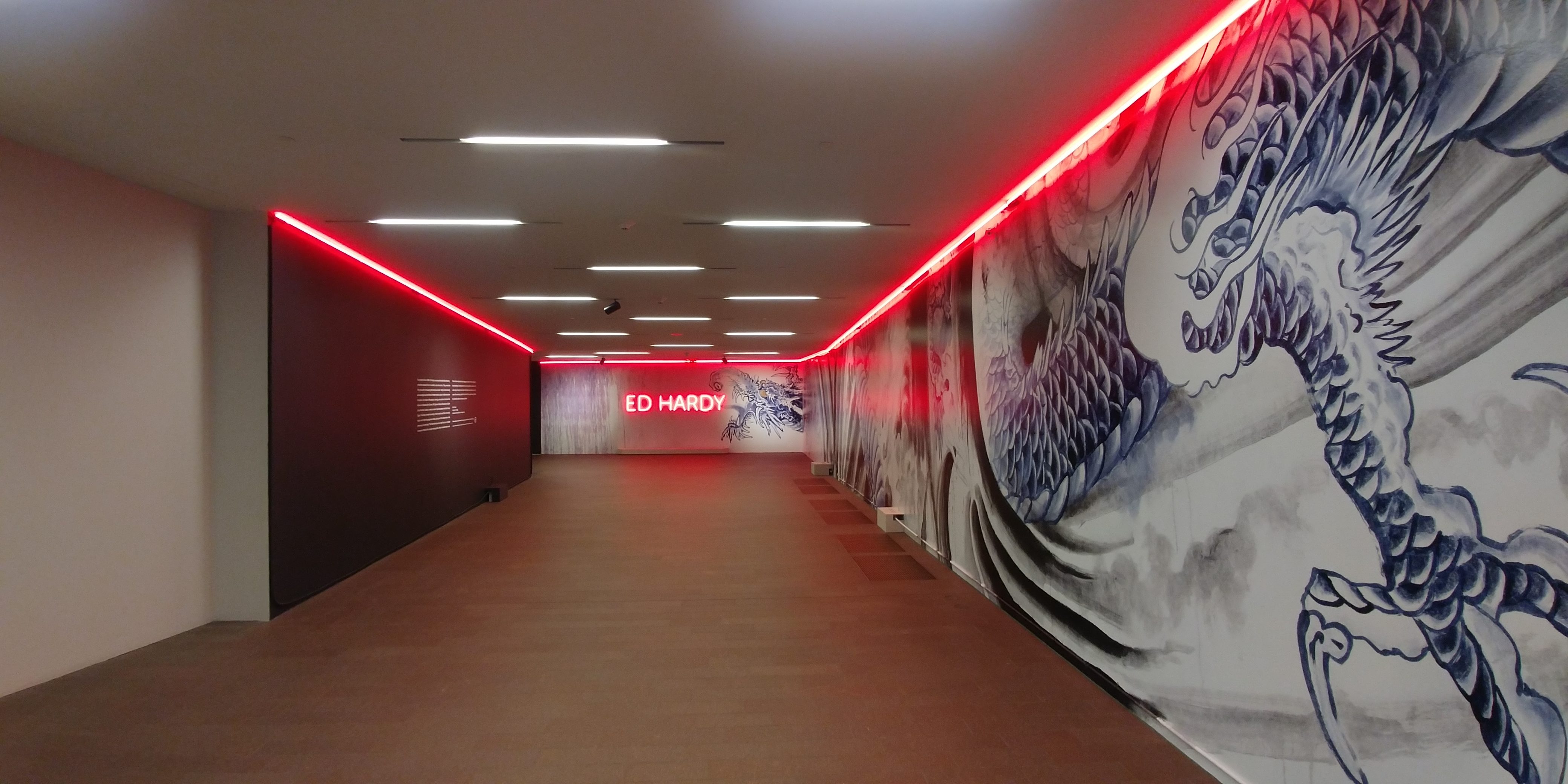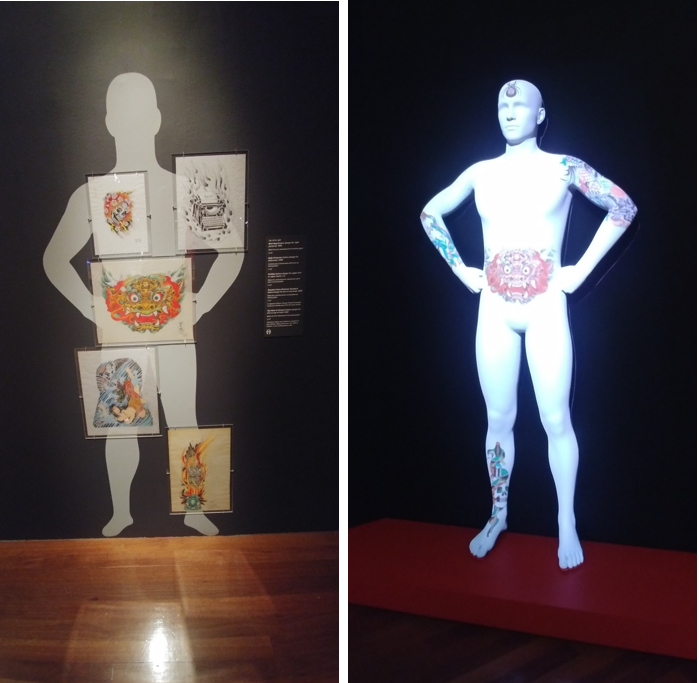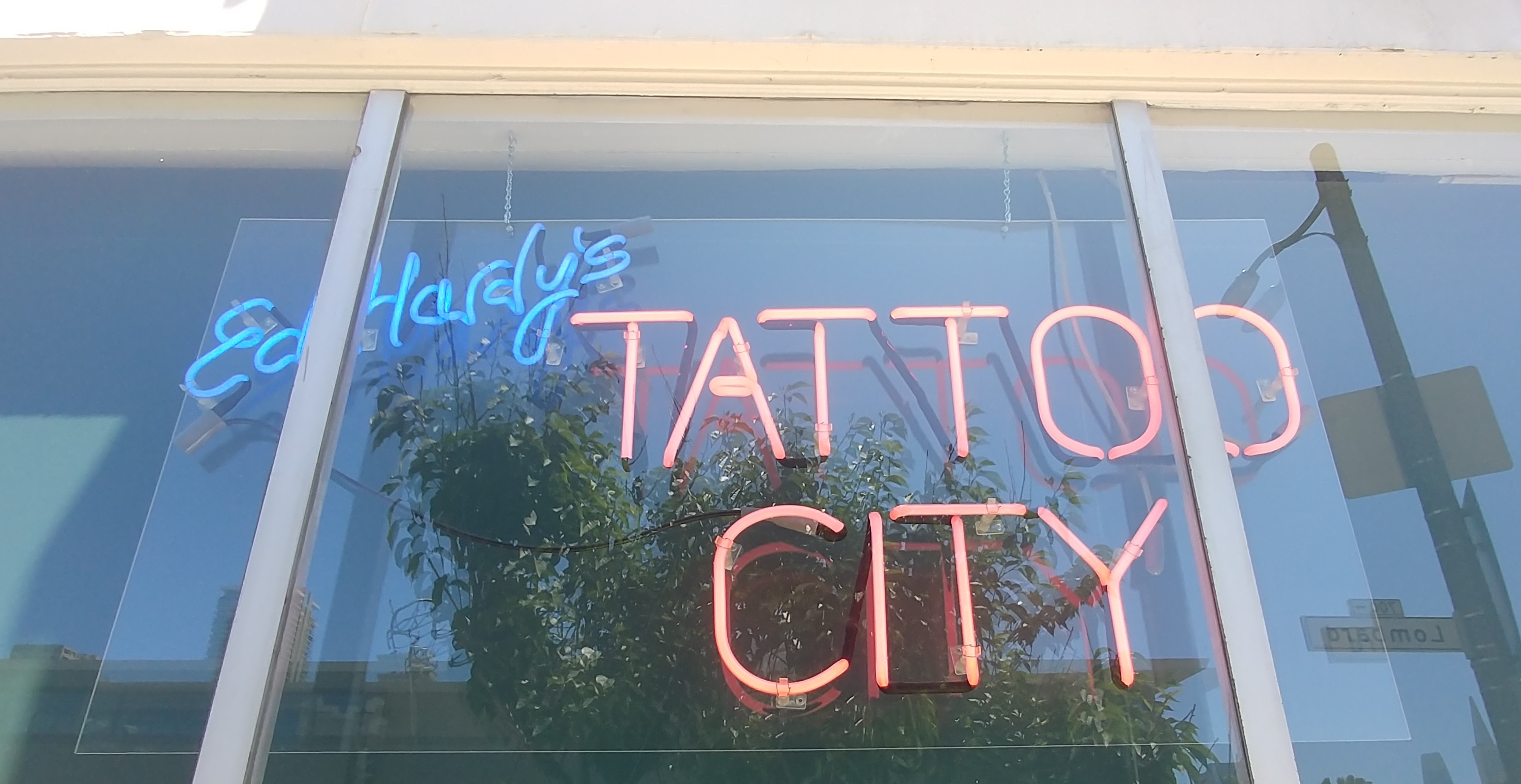
The De Young Museum in San Francisco is currently exhibiting “Ed Hardy: Art of the New Tattoo” from 13 July 2019 to 6 October 2019. Assembled mostly from the more than 150 pieces that Hardy donated to the museum’s collections, it represents the first comprehensive retrospective of the artist, designer, and tattoo scholar’s work. It is also emblematic of the way in which Hardy helped transform tattoos from a marginalized, fringe, and almost dangerous outsider art form that was even illegal in some states, as well as New York City, into a mainstream trend embraced by large numbers of diverse enthusiasts. For example, the De Young is offering various discounts through 25 August for differing sizes of tattoos, including free admission for full body ink.

Donald Edward Talbot Hardy was born on 5 January 1945 in Des Moines, Iowa, but grew up in Corona del Mar on the Pacific coast in Southern California. There, he became curious about the tattoos displayed by soldiers who had served in World War II or Korea, a group that included the father of one of his best friends. Intrigued, Hardy started haunting the few tattoo parlors that existed on the Pike amusement area in Long Beach. By the time he was ten years old, he started drawing pretend tattoos on his friends with Maybelline eyeliner as a part of typical childhood games like soldiers or “Cowboys and Indians” and eventually opened a pretend tattoo studio complete with a fake license like the legally required ones that were displayed in the real parlors. Also throughout this time, Hardy’s father, who had left the family to travel the world, ended up in Japan, from where he regularly sent back items with fascinating ukiyo-e imagery.
Encouraged by his mother and determined to make a living through art, Hardy continued exploring other local scenes, such as surfing, Hispanic culture, and Monster, or Weirdo, custom car detailing and its related T-shirts as pioneered by Ed “Big Daddy” Roth and Dean “Kid Jeff” Jeffries. Meanwhile, friends and teachers exposed Hardy to established artists from Francisco Goya, Edvard Munch, and Pablo Picasso to contemporary artists associated with the Beat Generation, Pop Art, and the Ferus Gallery in Los Angeles. Hardy started studying art seriously, exhibited his first works by the time he was 17, and, after becoming enamored by the completely different bohemian scene in Northern California, started classes at the San Francisco Art Institute, from which he graduated with a Bachelor of Fine Arts in printmaking in 1967, the year of the Summer of Love. [1]

The traditional style of the tempera-based “Self-Portrait with Goya” (1962) contrasts with four portrait plates from 2007, demonstrating some of the breadth of Hardy’s many influences.
Around this same time and to the consternation of his family and friends, Hardy rejected a full scholarship to Yale and instead reignited his earlier, all-encompassing interest in tattooing. He delivered a well-received lecture at the Art Institute about tattooing as a form of American folk art and started getting them from studios in Oakland. He also created the self-portrait etching “Future Plans” (1967), which depicts him displaying a full array of imagined upper-body flash. He started his first professional tattooing apprenticeship under Phil Sparrow, the “needle name” of author, painter, lecturer, and gay sexologist Samuel Steward, under whose guidance he administered his first tattoo onto his own leg in deference to the long-standing tradition for novices. Sparrow showed Hardy a book on irezumi, or Japanese tattooing, which became a key influence on the direction of his career by steering him away from the typical American flash styles that were still predominant at the time and towards a more complex and dramatic style that could use a person’s full body as the canvas. [2]
Hardy opened his first studio, Dragon Tattoo, in Vancouver, Canada, in 1968 for a brief period, but realized that he still needed to continue his training under the more experienced and established professionals that he found in Seattle, New York City, and San Diego, where he opened Ichiban Tattoo Studio in 1971. While studying Chinese art in California, Hardy started corresponding with and ultimately worked under legendary tattoo artist Sailor Jerry (Norman Collins) in Honolulu. Having important connections to tattoo artists all over the world, Jerry introduced Hardy to Japanese tattoo master Horihide (Kazuo Oguri). Hardy went to study with him in 1973, thus becoming the first non-Asian to ever study tattooing in Japan, and the unique experience provided him a substantial amount of instantly marketable credibility in the field.

Back in San Francisco in 1974, Hardy established the Realistic Tattoo Studio, which distinguished itself by being appointment-only and not displaying any flash while instead being entirely devoted to the creation of one-of-a-kind, often large-scale, pieces designed in collaboration with customers’ wishes. Jorma Kaukonen, the Finnish-American guitarist of Jefferson Airplane, and his wife were among the earliest customers. Later, after being inspired by the Chicano tattoos that were displayed at the first major tattoo convention in 1977 in Reno, Nevada, Hardy worked with saxophonist Robert “Buffalo” Roberts of Ruben and the Jets [3] to open Tattoo City the same year in San Francisco, where it continues to operate, along with Tattooland, a studio in East Los Angeles that he sold in 1984.

Hardy’s international reputation continued to grow, and he started traveling regularly to countries like England, Italy, and Japan, sometimes to organize or attend and otherwise contribute to tattoo conventions. In 1982, he established Hardy Marks Publications, which has produced a number of books about tattooing and other alternative arts, including the groundbreaking magazine Tattootime. Its first issue was devoted to “New Tribalism,” a term that originally referred specifically to the South Pacific style of thick, black tattooing but has since come to refer to a full lifestyle aesthetic. Also in the early 1980s, Hardy had drawn portraits for a “Skins and Skulls” series that share a similar aesthetic with the four portrait plates depicted above and were inspired by the contemporary club scene in London. Printed as a small book, they represented his earliest pieces in the long arc back to traditional art making. Other early works on display in the exhibition show how Hardy is technically grounded in a variety of media and the classical tradition, as demonstrated by side-by-side comparisons with similar pieces by other artists, such as Giorgio Morandi and Gordon Cook.

After moving part-time to Honolulu in 1986, Hardy started returning to his artistic roots by creating and exhibiting pieces in paint, watercolor, and other media. He also started giving lectures and contributing historical tattooing memorabilia to museum exhibitions and their accompanying catalogs. One of his most impressive pieces is 2000 Dragons, a four-foot-tall and five-hundred-foot-long scroll that he painted on industrial Tyvek material to commemorate the millennium. The gallery where it is on display features a background of “Scroll Sounds” of some of the music that Hardy listened to during the seven months that he worked on the piece. The eclectic mix ranges from Pink Floyd’s “One of These Days” and Muddy Waters’ “I Be’s Troubled” to Georg Friedrich Handel’s “Water Music, Suite No. 1” and Wilco’s “I’m Always in Love.”
In 2002, despite his own misgivings about the high-flying celebrity culture it represented, Hardy licensed his designs to Christian Audigier. Audigier had previously licensed custom car painter Von Dutch’s (Kenny Howard) iconic flying eyeball and other imagery, but the Hardy line became his most successful venture, especially after it opened numerous dedicated stores worldwide. [4] Though most of them have since closed and the partnership ended in a lawsuit in 2009 due to Audigier’s reworking and misappropriation of the imagery that led to a buy-back of the master license in 2011, Ed Hardy Originals continues to produce shirts, jackets, and other items as a joint venture between Hardy Way and the Iconix Brand Group. In the meantime, Hardy completed his last tattoo at Tattoo City in 2008 and continues to concentrate exclusively on producing art in other media.

In front of the large wall of flash seen above, there is an interactive screen that allows visitors to zoom in on the enlarged sheets. Similarly, in the last gallery dedicated to the “Life of a Tattooer,” visitors can zoom in on a photograph of Hardy displaying his tattoos and read about their history. The screen is surrounded by a later print series in which additional elements like fanciful headdresses have been added to the original “Future Plans” self-portrait, and visitors can compare the youthful prediction to the real way in which its designer’s skin actually ended up looking. In these ways, the exhibition can be somewhat overwhelming in its entirety due to the tremendous amount of intricate detail involved throughout. Since they are restricted to human scale, tattoos are inherently small images with many different kinds of patterns, shading, and the unexpected juxtaposition of wildly different images and iconography from a wide variety of traditions and cultures.
Furthermore, even though tattoos are an inherently difficult medium to preserve and display without the participation of tattooed individuals themselves, the exhibition used several effectively clever ways to depict them in addition to the two displays shown above. Ceiling projections allowed people to see what tattoos might look like on different parts of their bodies. Another display paired original stencils with photographs of the final tattoos as they appeared on customers. By providing a good chronological overview that allows visitors to explore the key phases and elements of Hardy’s career, his serious approach and dedication to art and the ways in which he revolutionized tattooing by going beyond its traditional confines are amply demonstrated.
Note
The new documentary Tattoo Uprising was screened at the Roxie Theater in San Francisco from 12 through 18 July 2019. It includes appearances by filmmakers Werner Herzog and Les Blank, both of whom have tattoos by Hardy, who in turn appeared in Alan Govenar and Blank’s film Stoney Knows How. Hardy, in turn, attended the showing on 15 July along with director Govenar, who originally started making the film in 1980. Additional photographs, essays, and reference materials are provided in the well-produced exhibition catalog Ed Hardy: Deeper than Skin: Art of the New Tattoo, edited by Karin Breuer with contributions from other authors.
Two other current exhibitions in San Francisco should also be noted. The Asian Art Museum is displaying the essentially companion-like and similarly cross-disciplinary “Tattoos in Japanese Prints” from 31 May to 18 August 2019 (http://www.asianart.org/exhibitions/tattoos-in-japanese-prints). One of the key pop artists whose career Hardy admired is being represented by the large retrospective “Andy Warhol — From A to B and Back Again” at the Museum of Modern Art from 19 May through 2 September 2019 (https://www.sfmoma.org/exhibition/andy-warhol-from-a-to-b-and-back-again/).
Text and Photographs by Nikolai Sadik-Ogli
Deeper Than Skin – Ed Hardy: Art of the New Tattoo
De Young Museum, San Francisco, California, 13 July 2019 – 6 October 2019
References
[1] Many more details about the different teachers, artists, and other influences that Hardy credits, including a catalog of many early tattooists and the most important museum collections to have them in America and Japan, can be found throughout Hardy’s autobiography Wear Your Dreams. This author reviewed how San Francisco celebrated the 50th Anniversary of the Summer of Love in the blog entry.
[2] Steward’s fascinating, multi-faceted career, and Hardy’s appearance within it, is fully chronicled in Justin Spring’s excellent biography Secret Historian.
[3] The band’s name had been inspired by Cruising with Ruben & the Jets, an album by the Mothers of Invention and Frank Zappa, who also produced the eponymous group’s first album. Roberts also played with Kaukonen and Jack Casady in Hot Tuna, which performed at the studio’s opening.
[4] In one of the best scenes from the Vif, Audigier’s friend François Girbaud wonders incredulously about how he had “managed to sell T-shirts to the American market,” which was “something no one had done before.”
Bibliography
Breuer, Karin, ed. Ed Hardy: Deeper than Skin: Art of the New Tattoo. New York: Rizzoli Electa, 2019.
Ed Hardy: Art for Life. New York: teNeues Publishing, 2009.
Ed Hardy: Interviews by V. Vale. San Francisco: RE/Search Publications, 2014.
Hardy, Ed. Wear Your Dreams: My Life in Tattoos. New York: Thomas Dunne Books, 2013.
Spring, Justin. Secret Historian: The Life and Times of Samuel Steward, Professor, Tattoo Artist, and Sexual Renegade. New York: Farrar, Straus and Giroux, 2011.
Vale, V. and Andrea Juno. Pranks! San Francisco: RE/Search Publications, 1987.
________. Modern Primitives: An Investigation of Contemporary Adornment and Ritual. San Francisco: RE/Search Publications, 1989.
Filmography
Christian Audigier the Vif (2017)
Ed Hardy: Tattoo the World (2010; https://vimeo.com/77325298)
Hori Smoku Sailor Jerry: The Life of Norman K. Collins (2008; https://www.youtube.com/watch?v=8CS9Fuw7ENg)
Signatures of the Soul (1984)
Stoney Knows How (1981; https://www.youtube.com/watch?v=_TsTaTiGIfg)
Tattoo City (1980)
Tattoo Nation (2013)
Tattoo Uprising (2019)
Webliography